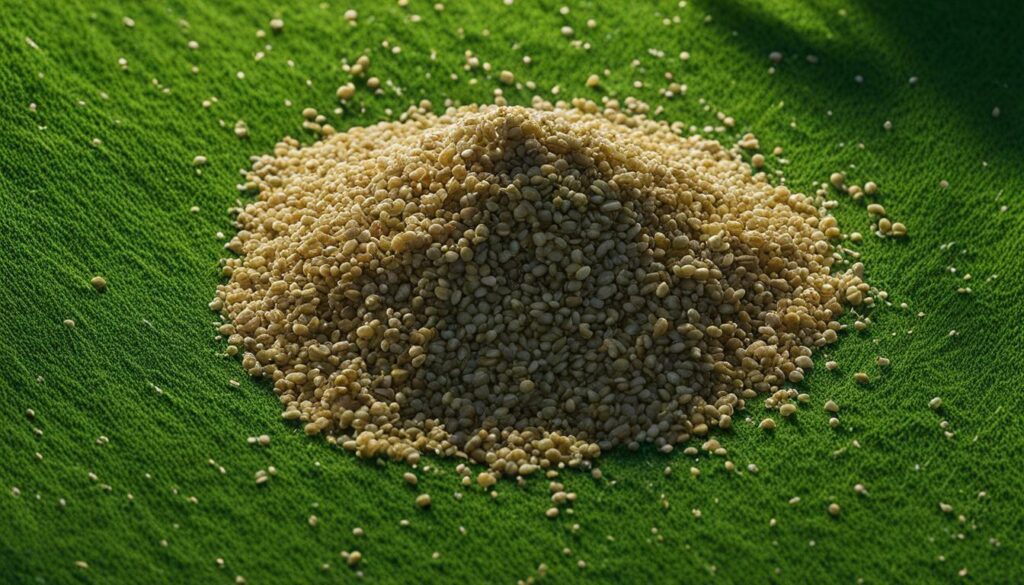Welcome to our comprehensive guide on choosing the right fertilizer for your lawn care needs. When it comes to maintaining a healthier and greener yard, the decision between liquid and granular fertilizer plays a crucial role. In this article, we will compare the two options and help you make an informed choice for your lawn.
Liquid fertilizer, such as High Nitrogen Liquid Lawn Food Fertilizer, AgroThrive All Purpose Organic Liquid Fertilizer, and Garden Lawn Liquid Spray, is a concentrate that is diluted with water and sprayed onto the lawn. It provides quick-release nutrients and is easy to apply with a garden hose attachment. On the other hand, granular fertilizer, such as Scotts Turf Builder Weed & Feed3, Scotts Turf Builder Triple Action, and Milorganite All-Purpose Eco-Friendly Slow-Release Fertilizer, is dry and comes in pellets. It is typically a controlled-release fertilizer that slowly releases nutrients over time.
The choice between liquid and granular fertilizer depends on factors like the lawn’s needs, grass type, time of year, and budget. Controlled-release granular fertilizer is recommended for long-term lawn health, while quick-release liquid fertilizer is ideal for fast results. Both types provide essential nutrients like nitrogen, phosphorus, and potassium, which help with growth, root development, and color.
In the following sections, we will explore the pros and cons of each type of fertilizer to help you make an educated decision and achieve the lush, green lawn you desire.
Pros and Cons of Liquid Fertilizer
Liquid fertilizer offers several advantages for your lawn care routine. One of the key advantages is its immediate nutrient availability. When you apply liquid fertilizer, the nutrients are quickly absorbed by the grass roots, resulting in fast results. This is particularly beneficial for new lawns or those that are in need of immediate attention.
Another advantage of liquid fertilizer is its even distribution of nutrients. When you spray the liquid onto your lawn, it provides a uniform spread of essential elements, promoting healthy growth throughout your yard. This ensures that all areas of your lawn receive the necessary nutrients to thrive.
The easy application of liquid fertilizer is another standout benefit. With a simple attachment to your garden hose, you can easily apply the liquid to your lawn without the need for additional tools or equipment. This makes the application process quick and convenient.
Additionally, liquid fertilizer can be mixed with herbicides or pesticides, providing a dual benefit of nourishing your lawn while also controlling weeds or pests. This makes it a versatile option for maintaining a healthy and vibrant yard.
However, it’s important to be aware of the potential disadvantages of liquid fertilizer. One potential downside is the possibility of a growth surge. While fast results are desirable, a sudden surge in growth can be challenging to manage for established lawns. It may require more frequent mowing and maintenance to keep your yard looking tidy and well-manicured.
Another consideration is the need for more frequent re-application compared to granular fertilizer. Liquid fertilizer is often less concentrated and requires more frequent treatments to maintain optimal nutrient levels in your lawn. This can be time-consuming, especially for larger lawns that require a larger quantity of liquid fertilizer.
Cost can also be a factor to consider. Liquid fertilizer tends to be more expensive than granular fertilizer, especially when applied to a large lawn. It’s essential to factor in the cost of ongoing treatments and balance it with your budget.
Finally, liquid fertilizer has a shorter shelf life compared to granular fertilizer. It is important to use liquid fertilizer within the recommended timeframe to ensure its effectiveness.
Pros and Cons of Granular Fertilizer
Granular fertilizer offers several advantages that make it a popular choice for lawn care. One of the major benefits is its slow-release formulation, which provides a steady supply of nutrients to the soil over time. This slow-release feature ensures that your lawn gets a consistent and continuous supply of essential nutrients. Additionally, granular fertilizer has a longer shelf life compared to liquid alternatives, meaning you can store it for longer periods without worrying about its effectiveness.
Another advantage of granular fertilizer is its cost-effectiveness, especially when bought in bulk. Purchasing larger quantities of granular fertilizer can result in significant savings, making it a budget-friendly choice for large lawns or regular maintenance needs. Furthermore, granular fertilizer is easy to see and monitor on the lawn, allowing you to visually assess the coverage and ensure even distribution.
However, there are a few drawbacks to consider when using granular fertilizer. One challenge is achieving an even distribution on the lawn, especially when spreading it manually without a spreader. Uneven distribution can lead to areas with too much or too little fertilizer, which may impact the overall health and appearance of your lawn. Additionally, there may be variations in nutrient distribution within the granules themselves, leading to inconsistent results.
Another disadvantage of granular fertilizer is its slower release of nutrients. While this can be beneficial for the long-term health of your lawn, struggling lawns that need an immediate boost may not receive the desired results as quickly as with liquid fertilizer. It is important to provide sufficient watering to allow the nutrients to reach the grassroots and ensure the proper absorption of the granules.
Furthermore, it’s worth noting that granular fertilizer typically contains more salt than liquid fertilizer. This higher salt content can promote intense heat at the grassroots level, which may have negative effects on your lawn’s overall health. Lastly, dust and broken particles in granular fertilizer can cause an uneven distribution of nutrients, further complicating its application process.
Which Type of Fertilizer, Liquid or Granular, is More Effective for Lawn Fertilization?
When considering lawn fertilization application amount, it’s important to choose the right type of fertilizer. Liquid fertilizers are fast-acting and easily absorbed by the grass, while granular fertilizers release nutrients slowly over time. Both can be effective, so choose the one that best fits your lawn’s needs.
Conclusion
When it comes to making the right lawn care decisions for your yard, choosing between liquid and granular fertilizer is an important consideration. Both options have their strengths and weaknesses, so it’s essential to understand the factors that influence lawn health, nutrient absorption, and overall cost-effectiveness.
Liquid fertilizer is known for its fast results and even distribution of nutrients. With the ability to customize mixtures and easy application, it’s a popular choice for immediate and targeted treatments. On the other hand, granular fertilizer provides slow-release nutrients for the long-term health of your lawn. It offers cost-effective options, especially when bought in bulk, and is easier to monitor on the grass.
Ultimately, the choice between liquid and granular fertilizer depends on your lawn’s specific needs, your personal preferences, and your budget. Consider factors like nutrient release speed, ease of application, and cost to make an informed decision. Remember to ensure proper nutrient absorption and avoid over-fertilizing to maintain a healthy lawn.











